Occasionally the frozen moments in my photographs allow me to see something that really piques my curiosity. And makes me wonder about the relationships between natural selection, behaviors and structural adaptations. Some of my images of this diving male Common Goldeneye are a case in point.
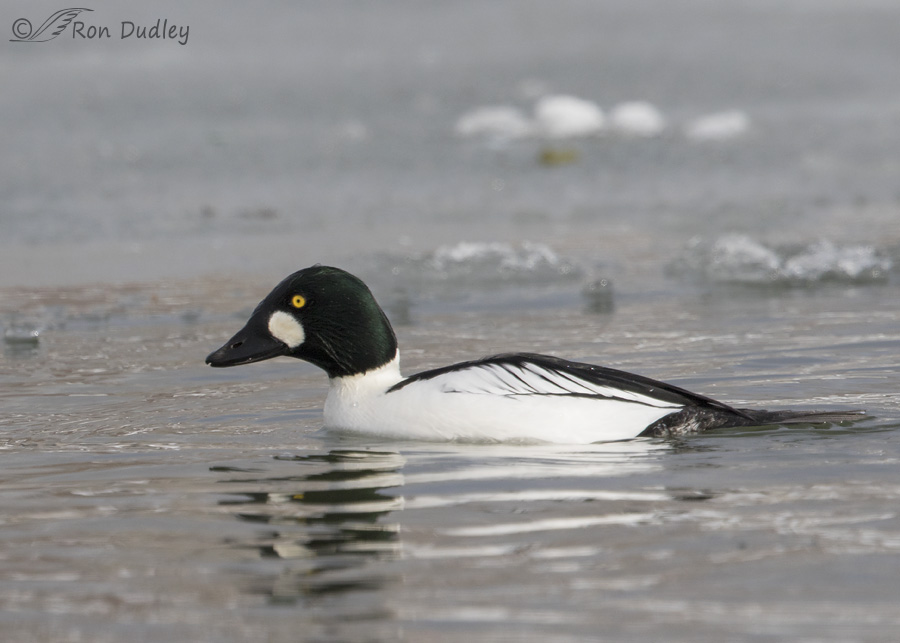
1/2500, f/6.3, ISO 400, Canon 7D Mark II, Canon EF 500mm f/4L IS II USM + EF 1.4 III Extender, not baited, set up or called in
I photographed him three days ago at a pond near my home. Once again the light angle on his head wasn’t ideal so those gorgeous glossy greens are pretty muted but this series demonstrates something I’ve noticed multiple times when this species dives.
The first six images in this post are sequential shots in a burst.
Here the bird is just about to dive. They compress their feathers slightly just before diving and that was my cue to begin my burst. Notice the length of the tail, spread out and flattened on the water’s surface behind the duck.
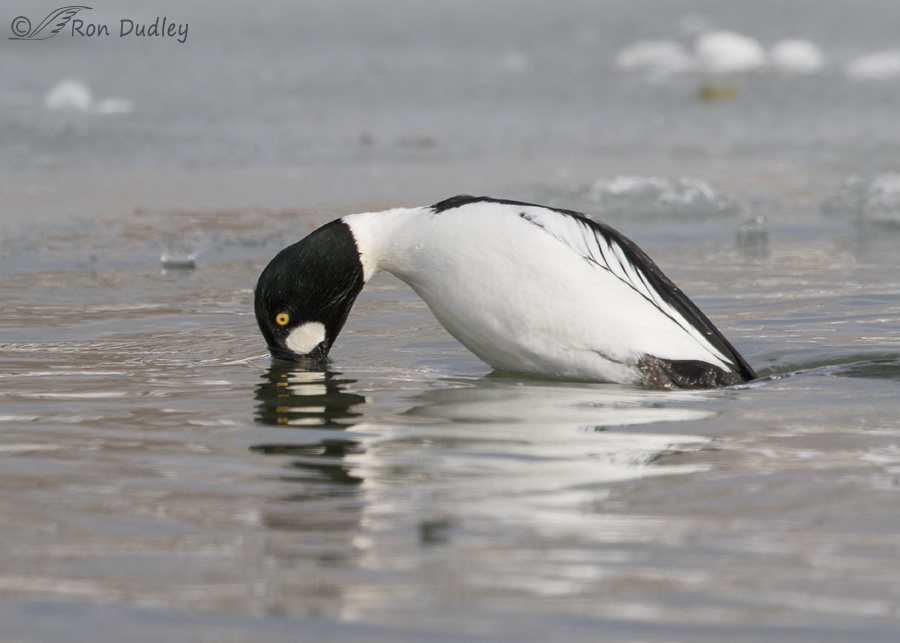
1/2500, f/6.3, ISO 400, Canon 7D Mark II, Canon EF 500mm f/4L IS II USM + EF 1.4 III Extender, not baited, set up or called in
As he begins his dive the flattened tail has flexed down into the water and disappeared.
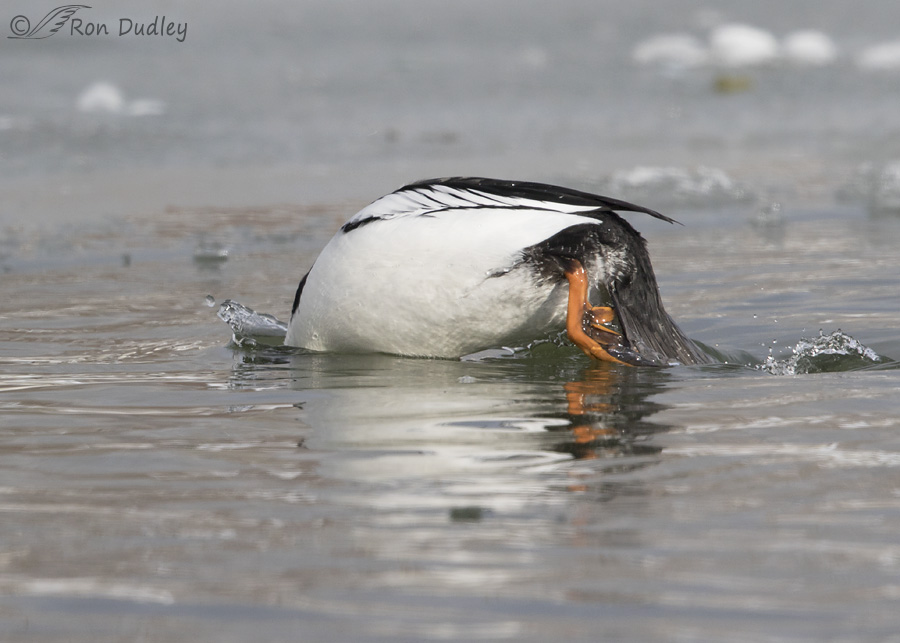 1/2500, f/6.3, ISO 400, Canon 7D Mark II, Canon EF 500mm f/4L IS II USM + EF 1.4 III Extender, not baited, set up or called in
1/2500, f/6.3, ISO 400, Canon 7D Mark II, Canon EF 500mm f/4L IS II USM + EF 1.4 III Extender, not baited, set up or called in
As the sharply flexed tail pushed down against the water…
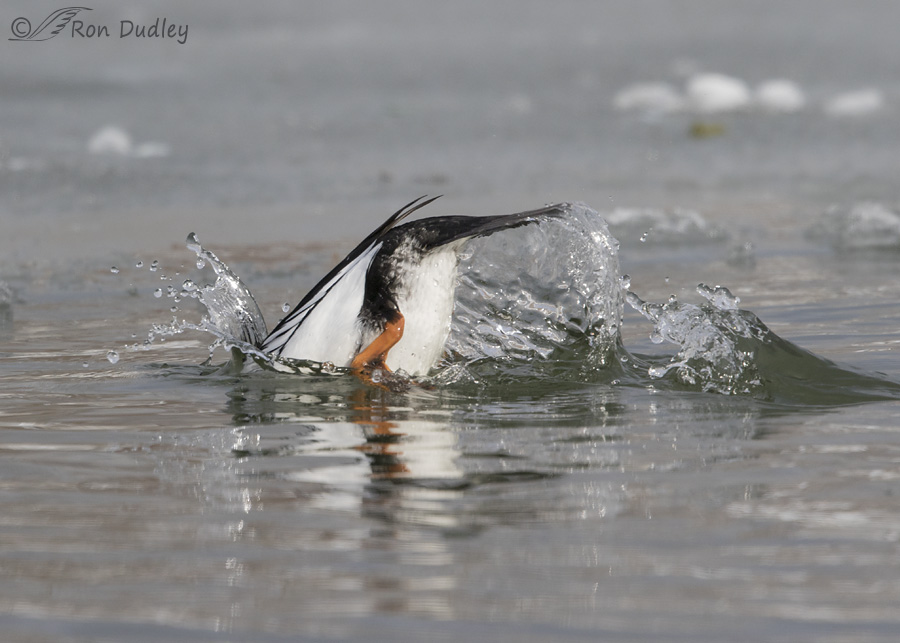
1/2500, f/6.3, ISO 400, Canon 7D Mark II, Canon EF 500mm f/4L IS II USM + EF 1.4 III Extender, not baited, set up or called in
it raised the rear end of the bird and that combined with the forward motion of the dive changed the angle of his body and helped to propel him downward.
Please notice the heavy curtain of water that has been cohesively pulled upward by the raised tail. I’ll come back to that in a minute.
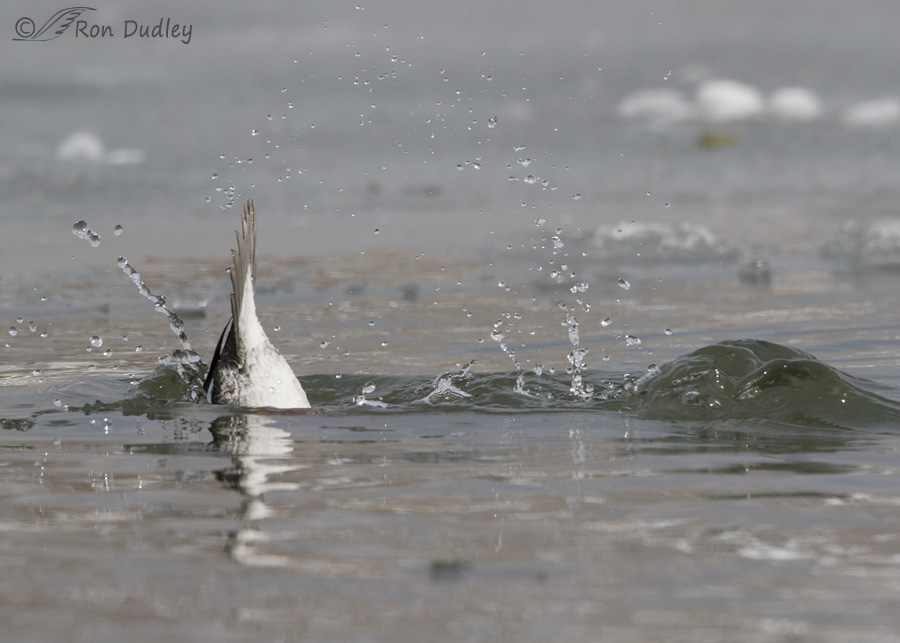
1/2500, f/6.3, ISO 400, Canon 7D Mark II, Canon EF 500mm f/4L IS II USM + EF 1.4 III Extender, not baited, set up or called in
As the bird begins to disappear beneath the surface his angle is perfectly vertical and the splash minimal – technique that would make Greg Louganis proud.
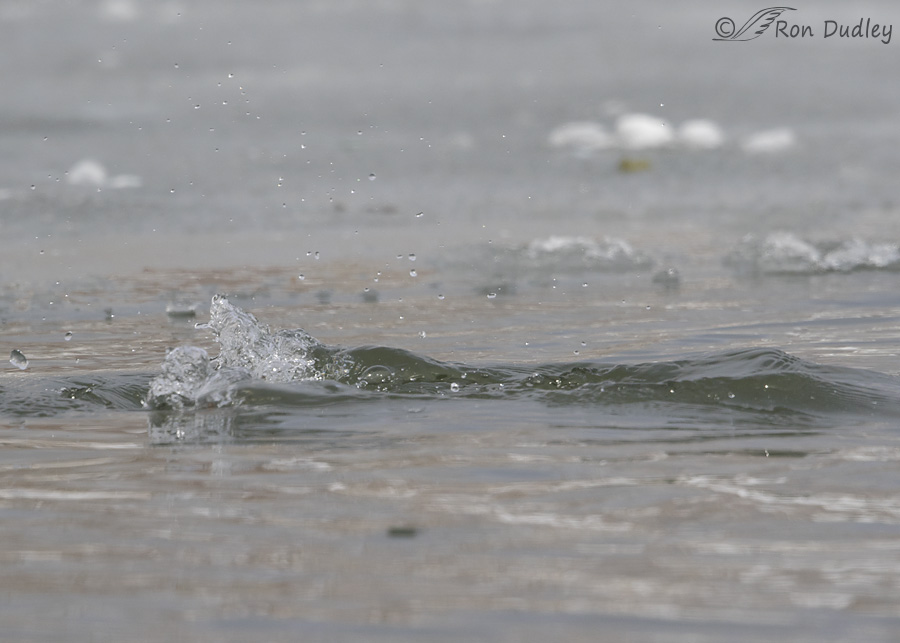
1/2500, f/6.3, ISO 400, Canon 7D Mark II, Canon EF 500mm f/4L IS II USM + EF 1.4 III Extender, not baited, set up or called in
As we see from the splash this dive was far from a belly flop.
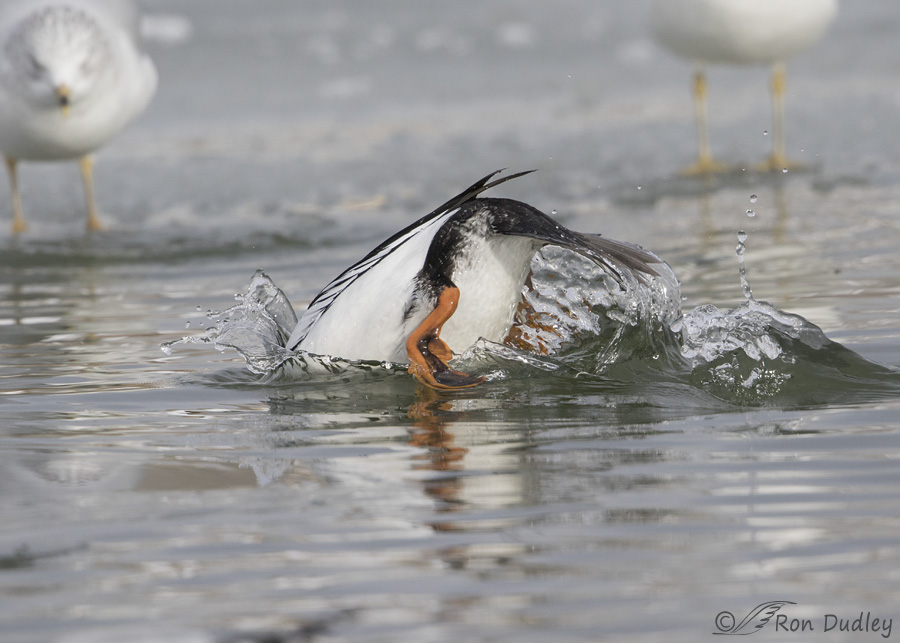
1/2500, f/6.3, ISO 400, Canon 7D Mark II, Canon EF 500mm f/4L IS II USM + EF 1.4 III Extender, not baited, set up or called in
Two minutes later I photographed the same male goldeneye in another dive (this time he has an audience of gulls). Once again, notice the heavy wall of water brought up by the tail – almost identical to the water curtain in the first dive. This seems to happen every time they dive and that made me wonder if it’s by design with this species. Consider the following:
- By necessity ducks are extremely buoyant so diving is physically exerting and energy demanding.
- To compensate for their buoyancy these birds compress their feathers to expel trapped air and exhale air just prior to the dive.
- So it seems logical that anything else that would help to force them beneath the surface would be advantageous to them.
So let’s go back to that heavy wall of water brought up by their flattened tail (it appears to happen every time this species dives). Since the cohesive and adhesive properties of water are causing the water curtain to “stick” to the tail its significant weight is helping to push the duck down into the water.
So, it seems to me that the shape and position of the tail when combined with the mechanics of the dive may all be designed (by natural selection) to reliably produce this raised wall of water that aids in forcing the duck beneath the surface.
I’ve attempted to research the subject but I found very little in the literature except for the following from BNA Online regarding the dives of Common Goldeneyes: “Dives easily without exaggerated leap or plunge”. It seems to me that they wouldn’t have mentioned that unless this species dives with less of an “exaggerated leap or plunge” than many other ducks. Perhaps the reason for that is the heavy water curtain brought up by their tail when they dive…?
And yes, I know that sometimes I dwell on minutia just a little too much. And I may be way off base. But as Popeye would say “I yam what I yam and that’s all what I yam“.
And that isn’t gonna change anytime soon…
Ron
PS – It’s 1 degree F as I type this at 6:30 AM. I haven’t seen it this cold in Salt Lake City for a very long time.
PSS – And it’s -19 F at my intended bird photography destination this morning. Geez, reminds me of my Montana days!


Fabulous. I’d love to hear from an engineer on this. 😉
Presumably, then, th varying relative lengths across diving-duck species impacts the mechanics of the dive. I had assumed that the cavity-nesting species (Bucephala, some mergansers) had long tails because tree cavities can be in forest, thus requiring a stronger, longer rudder for flight through such. While these two possible reasons might not be mutually exclusive, in fact, could be additive, your essay has opened new horizons in my fascination with the surface diving of various waterbirds. Note that the dives of loons are fairly different (they have very short tails). Another group of short-tailed surface divers is the grebes, in which diving behavior varies quite a bit across species and across situations. Much, much food for thought, for which I thank you.
Ron,
I will watch more closely for the flattening tail as I try to capture the same kind of series. Do the coots do it as well?
Stephen Clayson
No, coots don’t do it, Stephen.
I don’t know how many readers are taking the Cornell Ornithology course but Chapter 5 covers the subject of Avian Flight with a lot of physics included. The response of the air to bird movements is illustrated and discussed in detail in the text. Both air and water are fluids and act similarly although air is much less dense and viscous than water.
When I saw the tail push on the top of the water, I related it to the concept of lift and, yes, it lifted the breast of the bird out of the water. At the same time the goldeneye’s head is pointed downward by flexing the neck. Completing the tail flex forces the head and neck down underwater. The head and neck would then provide some vertical stability against the water column. The curtain of water stuck to the tail and the unattached splash behind the duck really illustrates the turbulence caused by the movement and made me think of the invisible turbulence illustrated by various wing positions in the text. Of course the heavier and stickier water acts differently than air. It makes sense that the water stuck to the tail could help force the bird underwater faster.
Pam, I have my own copy of Cornell’s new version of the Handbook of Bird Biology – the textbook for your course. I think it’s an exceptionally good resource (superlative, really) but I may be a bit biased because there’s a couple of my own images in the book. 🙂
The other action I observe is that they jump up in the air to dive in conjunction with what is going on in the hind end and I do not notice this as much with other ducks, although I will get back to observing in a few months.
Your half-baked theory sounds pretty well done to me. Thank you. And of course they make use of everything they can. Life is too hard for birds (and other animals) for them NOT to take any advantage they can.
On this side of the world we will be nudging 100 all week. I prefer your extremes. I find it much easier to get warm than it is to get (and stay) cool.
My theory sounds reasonably logical to me, EC – based on the photo evidence.
And you make a good point about staying cool in your temps.
I feel guilty…it was about 40 at 6 this morning…Ok,not that guilty..That’s why I live here in Arizona. As far as I’m concerned I’m pretty glad that “you am what you am..” …I sure have learned a lot from reading your blog these last few years…and I really enjoy the minutia..so please keep it up! Thank you
I appreciate the positive reinforcement, Steve. Thank you.
Please keep reporting the details of bird behavior! We all are learning so much from your photographs and observations. Thanks!
Don’t worry, Pat. I’m sure I’ll keep doing it at every opportunity. I just can’t help myself.
Velly velly interesting series and theory Ron! I just bet you are correct.
Charlotte
Once in a great while I turn out to be right, Charlotte. I suspect the jury’s still out on this one…
Ron, just the process of lifting the water would provide “an equal and opposite force” in the opposite direction; water lifted up = duck pushed down (at least a little). Once lifted, the water is no longer connected to the Goldeneye, so will just fall back into the pond.
Thanks, Richard.
I’ll third what Patty said! Fascinating series. It’s interesting to me that the tail feathers are still spread in the “Greg Lougainis” shot. I wonder too if that curtain perhaps breaks the surface tension of the water to help that big white belly submerge as well.
Stay warm today! (I’m not going to gloat about SoCal temps.) 😉
Interesting thought about the surface tension, Marty. Thank you.
Love this kind of stuff! As with sounding whales, anything that is out of the water is heavier and helps drive the creature down. It almost looks like that first tail thrust and curtain of water are hepling heave that big ole Golden-eye butt up out of the water. Marine mammals also exhale and compress brefore diving.
Thanks for the comparison to diving marine mammals, Porcupine. I didn’t even think of that.
Anything physics tends to shut my brain down, but I think I understand what you’re getting at here. Very interesting. I’m glad that you are so observant and that you share your observations with us. I like that you make me think about things that I would not otherwise consider about how our world works. And I second what Patty said.
I’m glad I didn’t overload you with physics on this one, Susan. Thanks.
It’s the resistance of the water (relatively heavy) to the upward thrust of the tail that provides the propulsion to complete the submersion. Nice photos. 1degree. Not me.
Thanks, Frank.
I am equally grateful for your wonderful photographic captures, comments and observant “wonderings”… That you are observant enough, and visually and intellectually quick enough, to notice these things, and then bring them to our attention, is a very much appreciated bonus. I get curious about things I notice, too, but I don’t even notice half the things you do…
Nicely worded. Exactly!
What a very nice comment, Patty. Thank you.
Fantastic series, Ron! Now I see what I’ve been missing every time I watch a Goldeneye dive! 6F here with a power outage 🙁
Sheesh! I hope your power comes back on quickly, Diane!
The Gull in the upper left seems as intent on understanding these diving mechanics as anyone! Your observations (and theory) are wonderful. Brilliant!
Thanks very much, Robert.
Interesting! No end to the adaptations out there that, unless carefully observing as you do, we mostly miss or don’t ponder if we do se it :)We’re at +10 this morning – relative “heat wave” after the sub-zero we’ve been having! Definitely “winter”
“Yes, “careful observation” is the key, Judy.
Only 10° warmer in the Ozarks with an inch of snow, way too cold for this southern gal. It is interesting how each species have evolved their own habits. Watching the birds mob the feeders this morning.
Jo, I saw -22 F in Box Elder County this morning…
Holy cow, that’s COLD!!!!!